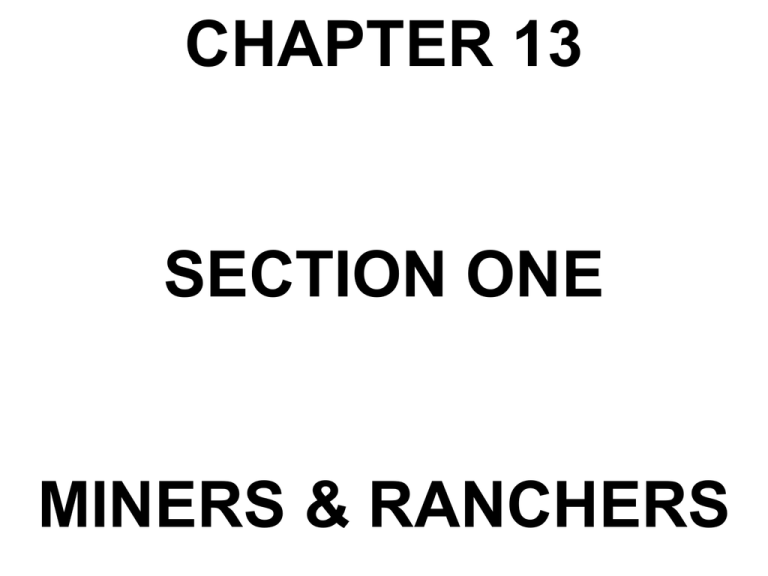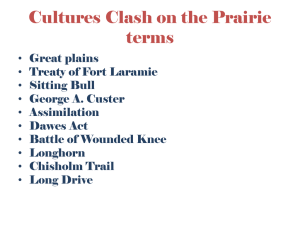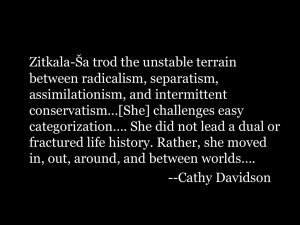Battle of the Little Bighorn - Findlay City Schools Web Portal
advertisement

CHAPTER 13 SECTION ONE MINERS & RANCHERS Mining Centers Virginia City Comstock Lode Prospecting Placer mining Quartz mining Long Drives to Railheads •Cattle shipped to slaughter houses. •Rise of the beef and meatpacking industry. •Development of the “Cowboy Culture” The Bronc Buster Frederick Remington Black Cowboys Exodusters 100,000 Exodusters leave the South and get involved with the ranching industry in Texas and Oklahoma. Barbed Wire Joseph Glidden •Barbed wire fence was a lifesaver because of the lack of wood in the dry plains of America. •Barbed wire also solved the problems between farmers and ranchers. CHAPTER 13 SECTION TWO FARMING THE PLAINS Homestead Act was a law developed in 1862 by Congress to promote settlement of the Great Plains. Age 21 and the head of the family could have 160 acres of land if they improved it in five years Could buy it for a small amount of $$$ $10.00 application fee The US Government encouraged westward expansion and the Homestead Act allowed thousands of settlers to move west and start new lives. •Settlers adapted to the difficult lifestyle of living on the Great Plains. •Newer advancements in agricultural technology helped settle the Plains. A Pioneer’s Sod House, SD • Dry farming Allows cultivation of arid (dry) land by using drought-resistant crops and various techniques to minimize evaporation. • John Griffin, a three-year homesteader says, "Yalls idea of dry farming has led me and me family through these three years that we been homesteading." Steel Plow Allowed farmers to cut through dense, root-choked sod. Mechanized Reaper Reduced labor force needed for harvest. Allows farmers to maintain larger farms. Powers irrigation systems and pumps up Steel Windmill ground water. CHAPTER 13 SECTION THREE NATIVE AMERICANS Tribes of the Great Plains Sioux Cheyenne Crow Arapaho Kiowa clash Differences in land ownership Railroad Settlers trespassing on Indian Land Discovery of gold Slaughter of the buffalo Broken treaties Negotiate treaties to sell land to US Americanization or assimilation Adopt Christianity White education Individual land ownership Adopt agriculture Take away food source to force to Reservations = tracks of land Map 13 of 45 •1871 to 1875, the US supported the extermination of 11 million buffalo. •Take away the food source from the Native American and they will be forced to submit and go to the reservations. Skull •Discovery of gold was often on Indian land. •Some of the key battles fought were around the mining areas. • Gold! Gold discovered in the Black Hills. • Govt. tries to purchase the land, but the Sioux refuse. • Gold fever and miners refuse to respect Sioux land….. • Conflict erupts! There goes the neighborhood! Events of the Indian Wars Sand Creek Massacre • 1864: The Army persuaded a group of Cheyenne to stop raiding farms and return to their Colorado reservation. • Then army troops attacked, killing about 150 people, and burned the camp. • Congress condemned the actions but did not punish the commander. Battle of the Little Bighorn • The Sioux responded to government relocation by joining other tribes near the Little Bighorn River. • Led by Sitting Bull, they slaughtered General Armstrong Custer’s smaller U.S. force. Wounded Knee Massacre • Army troops captured Sitting Bull’s followers and took them to a camp at Wounded Knee Creek. • Fighting began, and the soldiers slaughtered 300 Native American men, women, and children. • The massacre shocked Americans and broke Native American resistance. Sitting Bull and Crazy Horse • Sitting Bull (Sioux) and Crazy Horse (Cheyenne) were two chiefs who refused to sign the treaty. • They defiantly left the reservation. • "One does not sell the earth upon which the people walk" Crazy Horse Little Big Horn River, Montana 1876• George Armstrong Custer was sent to force the Sioux, Cheyenne and Arapaho back to their reservations. • He was in command of the 7th Calvary. • June 26, 1876 The Battle of Little Big Horn 1876 He was heavily outnumbered and trapped. Custer & all 220 of his men died. “Custer’s Last Stand” outraged Americans and led to govt. retribution. The Sioux and Cheyenne were crushed within a year. Little Bighorn Painting-Little Bighorn Little Bighorn Memorial-Little Bighorn The Ghost Dance Movement -1890 • Paiute medicine man Wovoka promised the return of the buffalo and Indian way of life. • The religion prophesied the end of the westward expansion of whites and a return of Indian land. • The ritual lasted five successive days, being danced each night and on the last night continued until morning. • Hypnotic trances and shaking accompanied this ceremony, which was supposed to be repeated every six weeks. Telegram to Washington, D.C. Nov. 15, 1890 "Indians are dancing in the snow and are wild and crazy. I have fully informed you that the employees and the government property at this agency have no protection and are at the mercy of the Ghost Dancers. ... We need protection and we need it now ...nothing [short] of 1000 troops will stop this dancing." Dr. Daniel F. Royer, Agent, Pine Ridge Agency Ghost Dance 4 The Ghost Dance Movement -1890 • Ghost Dance movement spread to Sitting Bull and the Sioux • They religiously danced even after they were told to stop by reservation authorities. • Military went to arrest Sitting Bull, where he was killed. • Many Sioux followers left the reservation and became hostile Battle of Wounded Knee – Dec.1890 • 7th Calvary rounded up starving and freezing Sioux and took them to Wounded Knee camp. • They attempted to confiscate all weapons. Battle of Wounded Knee – Dec.1890 • Violence erupted, 300 Indians and 25 whites lay dead. • This is the last of the Indian conflicts. Chief Big Foot Battle of Wounded Knee – Dec.1890 •The dead of Big Foot's people were buried in a mass grave. The still frozen stiff bodies were dumped unceremoniously into the hole. •The United States handed out over twenty Congressional Medals of Honor to soldiers of the Seventh Cavalry who had participated in the battle. Indian warriors fighting against the US wore Ghost Shirts which were to stop the penetration of American soldiers bullets……It gave them supernatural powers as was believed……… •Sioux reservation declined over the years…Why? Black Hills •Discovery of gold. •Resistance to move to the reservation •Battle of Wounded Knee Indian Assimilation Attempts • Native American children were taken to offreservation Indian schools where they would be taught white man’s ways. Dawes Act of 1887 Quicker Americanization Assimilate, mainstreamed and absorbed into US society Adopt Christianity and White education Individual land ownership Abandon tribe, culture and become farmers Male claimed 160 acres of land Children would be sent to Indian schools Farm land for 25 years. 1924 gain citizenship and right to vote Failed policy Indian resistance and corruption Dawes Act (1887) Carlisle Indian School, PA •With Indians on the reservation by 1890, the United States Census Bureau announced the official end of the frontier. •The population in the West had become dense, and the days of free western land had come to an end. •In 1893, historian Frederick Jackson Turner claimed that the frontier had played a key role in forming the American character. •The Turner Thesis, stated that frontier life created Americans who were socially mobile, ready for adventure, bent on individual self-improvement, committed to democracy and able to withstand difficult times to accomplish the American Dream… “RUGGED INDIVIDUALIST” The frontier created the American character of one who was self-sufficient, persistent and able to withstand difficult times to accomplish the American Dream… Frederick Jackson Turner








